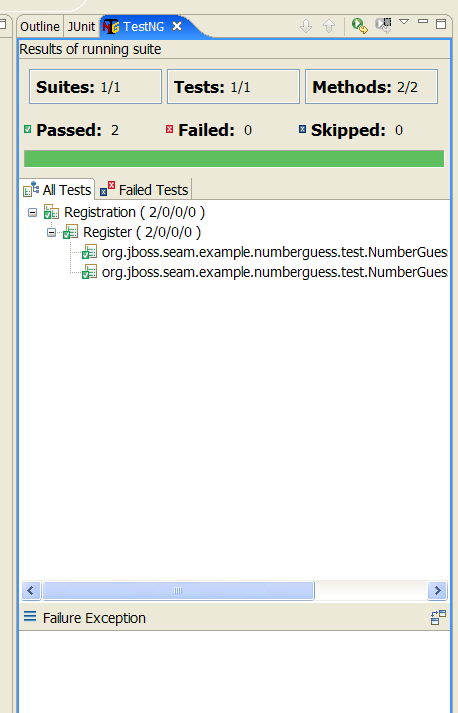Chapter 12. Testing Seam applications - JBoss Seam 1.0.0 正式版英文参考手册
Most Seam applications will need at least two kinds of automated tests: unit tests, which test a particular Seam component in isolation, and scripted integration tests which exercise all Java layers of the application (that is, everything except the view pages).
Both kinds of tests are very easy to write.
All Seam components are POJOs. This is a great place to start if you want easy unit testing. And since Seam emphasises the use of bijection for inter-component interactions and access to contextual objects, it's very easy to test a Seam component outside of its normal runtime environment.
Consider the following Seam component:
@Stateless
@Scope(EVENT)
@Name("register")
public class RegisterAction implements Register
{
private User user;
private EntityManager em;
@In
public void setUser(User user) {
this.user = user;
}
@PersistenceContext
public void setBookingDatabase(User em) {
this.em = em;
}
@IfInvalid(outcome=Outcome.REDISPLAY)
public String register()
{
List existing = em.createQuery("select username from User where username=:username")
.setParameter("username", user.getUsername())
.getResultList();
if (existing.size()==0)
{
em.persist(user);
return "success";
}
else
{
return null;
}
}
}We could write a TestNG test for this component as follows:
public class RegisterActionTest
{
@Test
public testRegisterAction()
{
EntityManager em = getEntityManagerFactory().createEntityManager();
em.getTransaction().begin();
User gavin = new User();
gavin.setName("Gavin King");
gavin.setUserName("1ovthafew");
gavin.setPassword("secret");
RegisterAction action = new RegisterAction();
action.setUser(gavin);
action.setBookingDatabase(em);
assert "success".equals( action.register() );
em.getTransaction().commit();
em.close();
}
private EntityManagerFactory emf;
public EntityManagerFactory getEntityManagerFactory()
{
return emf;
}
@Configuration(beforeTestClass=true)
public void init()
{
emf = Persistence.createEntityManagerFactory("myResourceLocalEntityManager");
}
@Configuration(afterTestClass=true)
public void destroy()
{
emf.close();
}
}
Seam components don't usually depend directly upon container infrastructure, so most unit testing as as easy as that!
Integration testing is slightly more difficult. In this case, we can't eliminate the container infrastructure; indeed, that is part of what is being tested! At the same time, we don't want to be forced to deploy our application to an application server to run the automated tests. We need to be able to reproduce just enough of the container infrastructure inside our testing environment to be able to exercise the whole application, without hurting performance too much.
A second problem is emulating user interactions. A third problem is where to put our assertions. Some test frameworks let us test the whole application by reproducing user interactions with the web browser. These frameworks have their place, but they are not appropriate for use at development time.
The approach taken by Seam is to let you write tests that script your components while running inside a pruned down container environment (Seam, together with the JBoss Embeddable EJB container). The role of the test script is basically to reproduce the interaction between the view and the Seam components. In other words, you get to pretend you are the JSF implementation!
This approach tests everything except the view.
Let's consider a JSP view for the component we unit tested above:
<html>
<head>
<title>Register New User</title>
</head>
<body>
<f:view>
<h:form>
<table border="0">
<tr>
<td>Username</td>
<td><h:inputText value="#{user.username}"/></td>
</tr>
<tr>
<td>Real Name</td>
<td><h:inputText value="#{user.name}"/></td>
</tr>
<tr>
<td>Password</td>
<td><h:inputSecret value="#{user.password}"/></td>
</tr>
</table>
<h:messages/>
<h:commandButton type="submit" value="Register" action="#{register.register}"/>
</h:form>
</f:view>
</body>
</html>We want to test the registration functionality of our application (the stuff that happens when the user clicks the Register button). We'll reproduce the JSF request lifecycle in an automated TestNG test:
public class RegisterTest extends SeamTest
{
@Test
public void testRegister() throws Exception
{
new Script() {
@Override
protected void updateModelValues() throws Exception
{
User user = (User) Component.getInstance("user", true);
assert user!=null;
user.setUsername("1ovthafew");
user.setPassword("secret");
user.setName("Gavin King");
}
@Override
protected void invokeApplication()
{
Register register = (Register) Component.getInstance("register", true);
String outcome = register.register();
assert "success".equals( outcome );
}
@Override
protected void renderResponse()
{
User user = (User) Component.getInstance("user", false);
assert user!=null;
assert user.getName().equals("Gavin King");
assert user.getUsername().equals("1ovthafew");
assert user.getPassword().equals("secret");
}
}.run();
}
...
}Notice that we've extended SeamTest, which provides a Seam environment for our components, and written our test script as an anonymous class that extends SeamTest.Script, which provides an emulated JSF request lifecycle. We've written our code in methods which are named for the various JSF phases, to emulate the calls that JSF would make to our components. Then we've thrown in various assertions.
You'll find plenty of integration tests for the Seam example applications which demonstrate more complex cases. There are instructions for running these tests using Ant, or using the TestNG plugin for eclipse:

